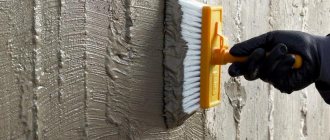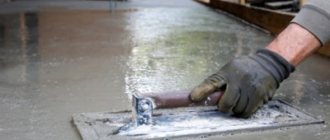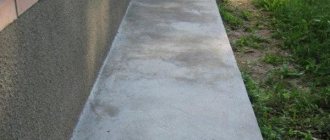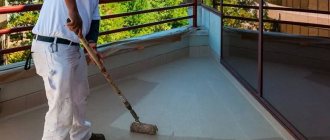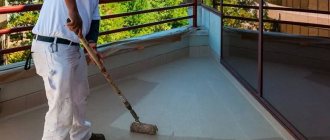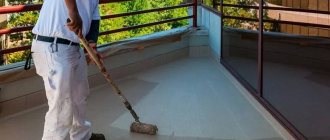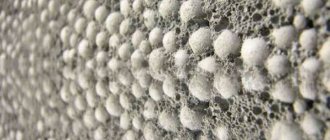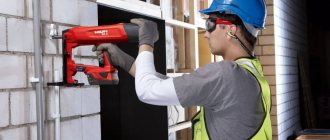SHARE ON SOCIAL NETWORKS
FacebookTwitterOkGoogle+PinterestVk
Concrete is the leading material used in the creation of various projects. Despite the fact that the building material is strong and durable, there are still negative factors that reduce the load-bearing capacity. This includes changes in humidity and temperature, exposure to ultraviolet radiation, shock and vibration loads. Ironing of concrete is a process that can prevent premature destruction of a structure by improving its qualities.
The ironing process extends the life of concrete and prevents deterioration
Why is it needed and what is the technology of ironing concrete surfaces?
During operation, hardened concrete is constantly exposed to various kinds of dynamic and mechanical loads. The ability to withstand negative factors will depend on the initial consistency of the concrete solution and its density. In order to improve the characteristics of the mixture, it is first recommended to carry out the following measures:
Ironing allows you to increase the positive characteristics of concrete
- use sand of different fractions;
- correctly select the optimal ratio of cement, water, plasticizers and fillers.
No matter how well the concrete is laid, there are still pores or microcracks that become gateways for moisture penetration. This is especially dangerous in a situation where there is a constant temperature difference (from plus to minus and vice versa). The smallest ice crystals that form inside the voids can expand them even in a short period, which will lead to the fact that the concrete will quickly begin to lose strength and collapse.
In addition, moisture that penetrates inside can also negatively affect the reinforcing elements located inside reinforced concrete structures. Chemically active elements that can penetrate into the structure along with precipitation also have a negative effect on concrete.
Important information! Despite the fact that concrete is considered one of the most durable building materials, it still has a certain shelf life. Considering that it is reinforced concrete structures that have the strongest and most critical impact, you need to be prepared for the fact that without additional measures, the surfaces may begin to crumble.
Ironing must be carried out at the construction stage or during repair work
A proven and effective option for combating such phenomena is considered to be closing cracks and small pores by ironing the surface. The procedure is performed at the construction stage of the building and during internal finishing activities. Ironing itself is a technological process aimed at increasing the strength of monolithic structures by applying special compounds to the surface that have high adhesion to the top layers.
Where is ironing of cement coatings used and what materials are needed for it?
The procedure is also relevant when performing interior finishing work, because even the process of applying plaster is accompanied by the penetration of moisture into microvoids, which leads to the destruction of monolithic parts. When there is a mechanical impact on the surface of the floor in the room, cracks appear, which over time lead to the process of crumbling, which can be combated by ironing the floor screed with cement. It is important to treat with a special compound immediately after filling, because this is how you can maximize the service life.
During construction, the blind area is ironed, which makes the foundation stronger and delays repairs. In fact, the main goal of the process is to increase the strength of the monolith, for which various components are used, including:
- dry mixes based on high grade cement;
- liquid or colloidal solutions with the addition of additives - most often liquid glass;
- materials with a high content of special polymers.
The ironing process is suitable for both interior and exterior work.
Interesting fact! Contrary to the name, in the process of ironing a concrete screed, neither iron nor other materials containing this element are used. The name only indicates the fact that surface hardening occurs, which is compared with the positive characteristics of iron.
The advantage is that you can do the work yourself, you just need to follow the technology and all the requirements of the manufacturer of the composition. Even the slightest non-compliance with the rules will lead to a violation of the composition, and the concrete will not meet the necessary requirements. If we talk about the process as a whole, then it is assigned the following functions:
- improvement of waterproofing;
- increasing the surface's resistance to loads;
- formation of a reliable layer that prevents abrasion;
- protection against crumbling, delamination and the formation of pores and cracks;
- quick preparation of surfaces for use.
How is ironing the surface of concrete carried out?
After the concrete layer is formed, under the influence of gravitational forces during hardening, heavy fillers slowly settle, which leads to a decrease in the density of the top layer. This process has an extremely negative effect on the strength of the structure as a whole, so it should be prevented.
Before ironing, the concrete surface must be thoroughly cleaned.
Strengthening concrete takes place using a special technology, which includes several mandatory manipulations:
- thorough cleaning of the treated surface from contaminants;
- preparation of the composition (subject to all requirements and recommendations given by the manufacturer);
- applying the finished solution to the surface.
After carrying out the above measures, you need to give the concrete some time to completely harden. There is no need to rush here, because the strength of the finished surface will depend on this. Ironing of concrete surfaces can be done in two ways:
- Dry. A dry cement mixture is used as an adhesive layer, after which the surface is well leveled.
- Wet. To strengthen, a liquid composition is prepared based on cement, colloidal mass or polymers.
Helpful information! If you reinforce concrete with your own hands, the proportions of the composition should be maintained in accordance with the instructions indicated on the packaging. You cannot change the ratio recommended by the manufacturer yourself, because it is quite possible to achieve the opposite effect and waste a large amount of material.
When preparing the composition, you must strictly adhere to the manufacturer’s recommendations
Why is such a process needed?
After the concrete floor has been poured, heavy fractions such as crushed stone begin to settle down under the influence of gravity. In this case, water is forced to the surface. As a result, the mixture becomes not homogeneous and the balance of concrete components in the upper layer is disturbed, as a result of which it becomes less durable.
The following factors influence the surface of a concrete product:
- Loads of various nature, including mechanical
- Natural moments, including rain, strong winds
- Effect of certain chemical reagents
- Temperature changes - freezing and thawing occur
These points greatly affect the concrete surface, which begins to slowly lose its characteristics, delaminates, and after some time cracks can be noticed. To prevent the destruction process, it is quite enough to make a protective coating of cement. This protective layer restores the balance of water and cement, which makes the surface more durable. As a result, resistance to mechanical stress, temperature changes and chemically aggressive environments increases. The water resistance indicator also increases, which is very important for concrete products outdoors. If concrete gets wet in the fall, then in winter the water, expanding when freezing, will destroy the structure of the concrete from the inside. Accordingly, the number of frost resistance cycles of the finished product will decrease significantly. Therefore, for example, ironing the blind area around the house must be done. It is worth noting that after this procedure the concrete surface will be flat, smooth and dust-free.
This is interesting: Heating concrete with electrodes: technology and installation diagram
Dry ironing of concrete: stages and features of implementation
Dry reinforcement of concrete with cement is considered the simplest and cheapest option. This method is carried out mainly for the purpose of strengthening horizontal surfaces, because the composition simply cannot hold on to a vertical wall. It is this drawback that is considered the most significant, because it reduces the scope of application and does not make it possible to strengthen vulnerable wall surfaces. Both pure Portland cement and mixtures of other materials are suitable for work.
Ironing a concrete floor allows you to increase the strength of the surface by increasing the amount of cement in the surface layer of concrete. The negative side of use is considered to be low adhesion. The cement mixture does not sufficiently saturate the concrete and does not penetrate to the required depth, which is why the top layer may begin to peel off over time.
Important! In order for ironing the screed with cement to give the desired result, high-grade cement must be used to prepare the mixture, and multicomponent mixtures will provide better adhesion.
Dry ironing of a floor screed or other horizontal surface should be carried out after the concrete has set, but the moisture on the surface has not completely evaporated. In most cases, experts recommend waiting 6-8 hours. After this time, a dry cement-based mixture is prepared with the addition of fine, clean, dry sand. In general, the technology of ironing concrete surfaces with cement involves the following stages:
The dry method is most optimal for processing floor screeds
- High-quality cement is poured onto the practically hardened concrete base. The layer thickness should not be less than 3 mm.
- To improve efficiency, it is recommended to sift cement through a sieve. Consumption is approximately 5 kg per m² of surface.
- After falling asleep, you need to wait until the cement layer completely absorbs all moisture from the surface of the screed. The mushy consistency of the mixture indicates that the work is ready.
- Using a trowel or spatula, rub the cement into the concrete. This must be done until the top layer is completely dry and turns a dark gray color.
Operation is possible within 24 hours after ironing the floor or other surfaces, but it is better to wait 4-7 days. This period will be enough for the surface to reach maximum strength.
Ironing the screed will be more effective if you rub a cement mixture into the surface with the addition of other components:
- quartz sand;
- liquid glass;
- sodium aluminate;
- basalt;
- polymer fibers.
Portland cement is most often used for dry ironing.
Adding these components will not only strengthen the surface better, but will also reduce the time it takes for excess moisture to be absorbed. It is especially important to use improved mixtures when treating floors in wet rooms, for example, in a bathroom, kitchen, bathhouse or sauna. The use of sodium aluminate not only increases the moisture-repellent properties of the floor, but also significantly reduces the amount of dust that forms and accumulates on the surface.
Types of reinforcement and scope of application
Ironing of concrete is the rubbing of dry cement into a freshly formed concrete surface to give it additional strength and moisture-proof properties. The point is that during processing, the number and size of voids and pores in the base decreases or disappears altogether, and the cement binder and other substances bind together the concrete structure subject to cracking, strengthening it. This makes the surface quality better.
Important! Applying a strengthening layer is the finishing work. That is, for example, the base of the floor should be laid by this moment, and, if required, already leveled with a screed.
Acquired surface water resistance
Strengthening can be done by several types of materials:
- Cement. Previously, reinforcement of the concrete surface was carried out using only high-grade cement. But a significant drawback of such processing forced us to improve the technology. The downside is that after some time (depending on the quality of the work performed), the top layer under regular loads certainly began to peel off and crumble.
Peeling of the reinforcing coating
- Topping. When preparing a strengthening solution, they began to try, in addition to cement, adding other components and microfibers to the composition to improve the quality of adhesion of the coating to concrete and its technical characteristics. Thus, special finely dispersed compositions based on Portland cement with various fillers were developed. They not only enhance strength properties, but also significantly increase resistance to moisture and mechanical stress. They also impart resistance to aggressive environments and other required qualities to ordinary concrete surfaces. These modified mixtures became known as toppings.
Note: the main thing in multicomponent mixtures is that their adhesion to the concrete base is improved. This means that with high-quality work, the likelihood of detachment of the reinforcing layer is minimized.
Leveling the concrete surface
- Impregnation. Along with topping, polymer coatings for impregnation have appeared that do not contain cement. Their main advantage is that the base does not have to be freshly laid. They can also be used on old surfaces for restoration and repair purposes. Moreover, the method of applying them is also much simpler than cement compositions.
Application of impregnating composition
More often, reinforcement of concrete surfaces is carried out when installing a floor covering, to strengthen the top layer of the screed, if there is one, or the base itself. But, if necessary, it is also used to strengthen vertical surfaces.
Depending on the type of composition used, it is possible to carry out treatment aimed at waterproofing - for example, under a swimming pool. And also, in production workshops with varying degrees of aggressiveness and ambient temperature in them. The table shows the price and information on the average consumption of some materials.
Comparison of brands of modern hardeners
Technology of ironing cement coatings using the wet method
The wet ironing method is considered universal, because it can be successfully used for processing both horizontal and vertical surfaces. In this case, not only a factory-made composition for reinforced concrete is used (in compliance with the supplier’s instructions), but also a mixture prepared independently.
Carrying out wet ironing of concrete surfaces with cement requires preliminary preparation of the solution. Here you will also need Portland cement or a solution of fine, clean sand, cement and water in a 1:1 ratio. The dry ingredients are mixed in a container until smooth, and then water is added little by little and, using a mixer attachment from a hammer drill, it is brought to readiness.
The finished mixture should resemble thick sour cream in appearance. If you plan to treat vertical surfaces, the consistency should be such that the applied layer (3-5 mm) does not flow off the walls and adheres tightly.
Wet ironing of concrete is considered a universal option
Checked! To increase the plasticity of cement mortar, experienced owners recommend adding 10% lime milk. When ironing plaster, it is permissible to include various dyes and dry pigments in the solution.
You can get the most smooth and perfectly flat surface by adding liquid glass, which will also increase the surface’s resistance to moisture. It is better to carry out work on ironing cement or concrete a week after pouring the concrete solution, until it has completely set and the water has completely evaporated.
Wet ironing of concrete surfaces with cement: how to do it correctly, tools
Before starting work, the surface should be cleaned. After applying a layer of the required thickness, the surface is carefully smoothed and then polished. To give an attractive appearance, a polyurethane coating or concrete paint is used. After wet ironing of concrete, the surface reaches maximum strength in 3-5 days. At the same time, during this period it is recommended to moisten the surface using a spray gun or spray gun.
Among the disadvantages is the possible detachment of the layer due to insufficient adhesion to the base. To avoid such problems, it is recommended to use a primer to strengthen the concrete and increase the adhesion strength of the compounds.
After the composition has been applied, the surface must be thoroughly smoothed and polished.
To polish surfaces, trowels, floats and other mechanical methods are often used. If we are talking about a large area that needs to be processed, such methods will be expensive not only physically, but also in time. Therefore, in such cases, the best way out of the situation is the use of trowels, which are available in a large assortment on the shelves of hardware stores. Many people recommend purchasing a used tool to save money, but it should be carefully inspected and tested before purchasing.
Cars also have their drawbacks. Thus, with their help it is convenient to process flat surfaces, but it will not be possible to process corners or raised areas of concrete. In this case, only manual work is suitable.
Related article:
Liquid glass for concrete: the versatility of silicate mixture
Composition of the solution, scope of application, rules of use. Drawing up proportions. Cost of the mixture and customer reviews.
Features of using polymer impregnations to strengthen concrete
Polyurethane compounds for ironing are in greatest demand among consumers, because they are considered an effective way to increase the strength of concrete surfaces. It’s easy to do the processing yourself and still get excellent results. Colloidal mixtures are characterized by the presence of liquid glass and polyurethane in their composition.
Important information! Strengthening with liquid glass has a large number of advantages, the main ones being quick drying of the surface and smoothness. The negative aspects include the fact that when carrying out wet cleaning, the glue is gradually washed away from the surface, which is why the strength decreases.
Colloidal substances for strengthening concrete contain polyurethane and liquid glass
In general, the polymer is considered a deep penetration impregnation for strengthening concrete, because it penetrates 5 mm into the pore depth. The compositional features allow polyurethane-based solutions to be used even under extreme environmental conditions, for example, at constantly low temperatures.
To obtain a protective layer, concrete strengthening liquid is applied using a sprayer. 1-2 hours after application, the concrete is rubbed using a brush. In addition to the fact that the solution can be used in construction and repairs, it is also suitable for restoration work, when the walls of an old building are strengthened to prevent its destruction.
As in previous cases, before ironing, the surfaces should be thoroughly cleaned of dust and other contaminants, and then treated with a primer. It is better to repeat the process of applying primer 2-3 times. In this case, the material must be distinguished by its ability to penetrate deep into the concrete.
To improve operating efficiency, before purchasing, you need to clarify the permissible temperature range of use, as well as other application rules. Products intended for dry ironing, used on the principle of dry cement compositions, are also available for purchase. But due to their low efficiency, they are not widely used.
Polymer impregnations are able to reliably strengthen concrete due to the ability of deep penetration
Polymer processing
Recently, colloidal mixtures containing polymers or silicate compounds have been used to strengthen concrete structures. The addition of liquid glass has an antistatic effect, preventing the settling and accumulation of dust.
The advantages of this technology include increased surface smoothness and faster drying speed. A negative point is the gradual washing out of liquid glass with each subsequent cleaning, which significantly reduces its strength.
Polymer mixtures for reinforced concrete based on polyurethane are considered the most effective materials. Polymer impregnations penetrate into the depth of the coating by 5 mm or more, well strengthening the created layer. The work is carried out regardless of the time of year and ambient temperature. The polymer is sprayed with a special spray bottle. After 50-60 minutes, the concrete is wiped with a special brush.
How much cement is needed for 1 cubic meter of concrete?
Such compositions provide a reliable hydrophobic layer that is not subject to delamination. The monolith remains unchanged throughout the entire period of operation. To obtain the desired color, dyes are added to the composition.
To increase efficiency, you need to know the specific temperature range provided for the operation of the composition, and familiarize yourself with the rules of use.
The high price of polymer compositions for reinforced concrete is paid off by a long period of operation, increased reliability, absolute environmental safety, and decent coating strength.
Filling the pores in the outer layer with polymer, silicate glue or cement laitance significantly increases the strength of the monolith. Thanks to complete waterproofing, which protects against the destructive effects of water, the service life of concrete increases. Accordingly, the duration of operation pays for the cost of the iron itself many times over.
What are topping mixtures and what are they?
Topping compositions are divided into groups according to the degree of strength:
- quartz - characterized by an average level of strength;
- corundum - reliable mixtures;
- metallized - super durable.
Quartz topping is considered the most popular because, as already noted, quartz is suitable for surfaces that are located in rooms with high humidity and are intended for long-term use.
Corundum is considered one of the hardest stones, and additives based on this material not only increase the strength characteristics of concrete, but also improve its ability to withstand significant mechanical loads. Corundum-based solutions are excellent for strengthening concrete surfaces at gas stations, service stations, parking lots, underground and surface parking lots.
Topping with metal shavings is used to improve the strength properties of reinforced surfaces in factories and industrial enterprises. Due to the fact that the material is susceptible to corrosion processes, it is not recommended for use in social or residential buildings. The mixture is applied to the prepared surface 6-7 hours after pouring.
Topping compositions are: metallized, quartz, corundum
The composition is evenly distributed over the surface. After excess moisture is absorbed, the plane is smoothed out. Then the remaining topping is applied again, after which the surface must be rubbed again. After 3 hours, the plane is ground and treated with curing - a special impregnation for concrete. Before final hardening, the surfaces are covered with film. After 2-3 days, expansion joints are made using a grinder, going deep into the surface of the slab, which are filled with polyurethane filler to completely seal it.
Restoration of old cement-sand coatings
All of the above methods are done only on fresh concrete, but in some cases the old concrete coating is also ironed.
It will not be possible to restore the mechanical properties of such a surface, but it is possible to create a new layer and repair cracks and chips with it.
The technology is very simple, so anyone can do this “trick.”
- The surface of old concrete must be cleaned of dirt and dust using a wire brush.
- Coat old concrete with a primer with increased penetrating properties. The adhesion of the surface will depend on how well you do this.
- Make a solution for ironing using the “wet” method with the addition of quartz or corundum sealants, as well as reinforcing polymer fibers, and carefully repair all chips and potholes.
- After setting, apply a thin layer of this solution to the entire surface to be restored and level it thoroughly.
